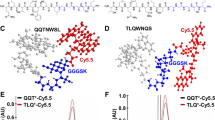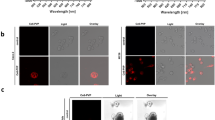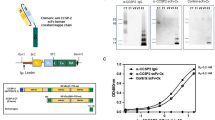Abstract
A combination of targeted probes and new imaging technologies provides a powerful set of tools with the potential to improve the early detection of cancer. To develop a probe for detecting colon cancer, we screened phage display peptide libraries against fresh human colonic adenomas for high-affinity ligands with preferential binding to premalignant tissue. We identified a specific heptapeptide sequence, VRPMPLQ, which we synthesized, conjugated with fluorescein and tested in patients undergoing colonoscopy. We imaged topically administered peptide using a fluorescence confocal microendoscope delivered through the instrument channel of a standard colonoscope. In vivo images were acquired at 12 frames per second with 50-μm working distance and 2.5-μm (transverse) and 20-μm (axial) resolution. The fluorescein-conjugated peptide bound more strongly to dysplastic colonocytes than to adjacent normal cells with 81% sensitivity and 82% specificity. This methodology represents a promising diagnostic imaging approach for the early detection of colorectal cancer and potentially of other epithelial malignancies.
This is a preview of subscription content, access via your institution
Access options
Subscribe to this journal
Receive 12 print issues and online access
$209.00 per year
only $17.42 per issue
Buy this article
- Purchase on Springer Link
- Instant access to full article PDF
Prices may be subject to local taxes which are calculated during checkout





Similar content being viewed by others
Change history
21 March 2008
In the version of this article initially published online, the name of the first author, Pei-Lin Hsiung, was misspelled as Pei-Lei Hsiung. The error has been corrected for all versions of the article.
References
Vogelstein, B. et al. Genetic alterations during colorectal-tumor development. N. Engl. J. Med. 319, 525–532 (1988).
Winawer, S.J. et al. Prevention of colorectal cancer by colonoscopic polypectomy. The National Polyp Study Workgroup. N. Engl. J. Med. 329, 1977–1981 (1993).
American Cancer Society. Cancer Facts & Figures 2007 (American Cancer Society, Atlanta, 2006).
Kudo, S. et al. Colonoscopic diagnosis and management of nonpolypoid early colorectal cancer. World J. Surg. 24, 1081–1090 (2000).
Mayer, R., Wong, W.D., Rothenberger, D.A., Goldberg, S.M. & Madoff, R.D. Colorectal cancer in inflammatory bowel disease: a continuing problem. Dis. Colon Rectum 42, 343–347 (1999).
Garcea, G. et al. Molecular biomarkers of colorectal carcinogenesis and their role in surveillance and early intervention. Eur. J. Cancer 39, 1041–1052 (2003).
Goldsmith, S.J. Receptor imaging: competitive or complementary to antibody imaging? Semin. Nucl. Med. 27, 85–93 (1997).
Scott, J.K. & Smith, G.P. Searching for peptide ligands with an epitope library. Science 249, 386–390 (1990).
Kelly, K.A. & Jones, D.A. Isolation of a colon tumor specific binding peptide using phage display selection. Neoplasia 5, 437–444 (2003).
Abraham, J.M. et al. Novel decapeptides that bind avidly and deliver radioisotope to colon cancer cells. PLoS ONE 2, e964 (2007).
Kelly, K., Alencar, H., Funovics, M., Mahmood, U. & Weissleder, R. Detection of invasive colon cancer using a novel, targeted, library-derived fluorescent peptide. Cancer Res. 64, 6247–6251 (2004).
Zangani, D. et al. Multiple differentiation pathways of rat mammary stromal cells in vitro: acquisition of a fibroblast, adipocyte or endothelial phenotype is dependent on hormonal and extracellular matrix stimulation. Differentiation 64, 91–101 (1999).
Walters, R.W. et al. Basolateral localization of fiber receptors limits adenovirus infection from the apical surface of airway epithelia. J. Biol. Chem. 274, 10219–10226 (1999).
Pasqualini, R. & Ruoslahti, E. Organ targeting in vivo using phage display peptide libraries. Nature 380, 364–366 (1996).
Carson-Walter, E.B. et al. Cell surface tumor endothelial markers are conserved in mice and humans. Cancer Res. 61, 6649–6655 (2001).
Arap, W. et al. Steps toward mapping the human vasculature by phage display. Nat. Med. 8, 121–127 (2002).
Wang, T.D. et al. Functional imaging of colonic mucosa with a fibered confocal microscope for real-time in vivo pathology. Clin. Gastroenterol. Hepatol. 5, 1300–1305 (2007).
Fujimoto, J.G. Optical coherence tomography for ultrahigh resolution in vivo imaging. Nat. Biotechnol. 21, 1361–1367 (2003).
Wang, T.D. et al. Fluorescence endoscopic imaging of human colonic adenomas. Gastroenterology 111, 1182–1191 (1996).
Haringsma, J. et al. Autofluorescence endoscopy: feasibility of detection of GI neoplasms unapparent to white light endoscopy with an evolving technology. Gastrointest. Endosc. 53, 642–650 (2001).
Machida, H. et al. Narrow-band imaging in the diagnosis of colorectal mucosal lesions: a pilot study. Endoscopy 36, 1094–1098 (2004).
Messmann, H., Knuchel, R., Baumler, W., Holstege, A. & Scholmerich, J. Endoscopic fluorescence detection of dysplasia in patients with Barrett's esophagus, ulcerative colitis, or adenomatous polyps after 5-aminolevulinic acid-induced protoporphyrin IX sensitization. Gastrointest. Endosc. 49, 97–101 (1999).
Folli, S. et al. Immunophotodiagnosis of colon carcinomas in patients injected with fluoresceinated chimeric antibodies against carcinoembryonic antigen. Proc. Natl. Acad. Sci. USA 89, 7973–7977 (1992).
Keller, R., Winde, G., Terpe, H.J., Foerster, E.C. & Domschke, W. Fluorescence endoscopy using a fluorescein-labeled monoclonal antibody against carcinoembryonic antigen in patients with colorectal carcinoma and adenoma. Endoscopy 34, 801–807 (2002).
Kiesslich, R. et al. Confocal laser endoscopy for diagnosing intraepithelial neoplasias and colorectal cancer in vivo. Gastroenterology 127, 706–713 (2004).
Ho, S.B. et al. Heterogeneity of mucin gene expression in normal and neoplastic tissues. Cancer Res. 53, 641–651 (1993).
Moore, A., Medarova, Z., Potthast, A. & Dai, G. In vivo targeting of underglycosylated MUC-1 tumor antigen using a multimodal imaging probe. Cancer Res. 64, 1821–1827 (2004).
Soler, A.P. et al. Increased tight junctional permeability is associated with the development of colon cancer. Carcinogenesis 20, 1425–1431 (1999).
Peles, E. et al. Identification of a novel contactin-associated transmembrane receptor with multiple domains implicated in protein-protein interactions. EMBO J. 16, 978–988 (1997).
Su, J.L. et al. Knockdown of contactin-1 expression suppresses invasion and metastasis of lung adenocarcinoma. Cancer Res. 66, 2553–2561 (2006).
Acknowledgements
The authors acknowledge funding support from the US National Institutes of Health, including U54 CA105296 (NCI), K08 DK067618 (NIDDK) and P30 DK56339 (DDC Pilot Award), from the Doris Duke Charitable Foundation, from the Stanford School of Medicine Dean's Fellowship (P.-L.H.) and from the Cynthia Fry Gunn Research Fund. P.-L.H. is supported by the Canary Foundation/American Cancer Society Early Detection Postdoctoral Fellowship. We thank J. Kosek for support with histopathological interpretation and Mauna Kea Technologies for technical support and use of their clinical Cellvizio-GI imaging system.
Author information
Authors and Affiliations
Contributions
P.-L.H. conducted most of the experiments, with help from A.P.W. and J.H. (library clearing and cell line screening), C.B.D., P.S. and T.D.W. (clinical coordination), and T.D.W., S.F. and R.S. (in vivo studies). P.-L.H., J.H. and T.D.W. conducted the data analysis. P.-L.H., J.H., J.M.C., A.W.L., C.H.C. and T.D.W. were responsible for the concepts and writing of the manuscript. R.S., C.H.C. and T.D.W. supervised the project.
Corresponding author
Supplementary information
Supplementary Text and Figures
Supplementary Figs. 1–3, Supplementary Tables 1 and 2, and Supplementary Methods (PDF 692 kb)
Supplementary Video 1
In vivo video of peptide binding to a dysplastic crypt adjacent to normal mucosa. Real time video following peptide administration shows increased binding to colonocytes of a dysplastic crypt (left half) compared to normal crypts (right half). Imaging of border provides a uniform field of view for comparison. (MOV 2737 kb)
Rights and permissions
About this article
Cite this article
Hsiung, PL., Hardy, J., Friedland, S. et al. Detection of colonic dysplasia in vivo using a targeted heptapeptide and confocal microendoscopy. Nat Med 14, 454–458 (2008). https://doi.org/10.1038/nm1692
Received:
Accepted:
Published:
Issue Date:
DOI: https://doi.org/10.1038/nm1692
This article is cited by
-
Flexible-type ultrathin holographic endoscope for microscopic imaging of unstained biological tissues
Nature Communications (2022)
-
High-speed light-sheet microscopy for the in-situ acquisition of volumetric histological images of living tissue
Nature Biomedical Engineering (2022)
-
A Pretargeted Imaging Strategy for EGFR-Positive Colorectal Carcinoma via Modulation of Tz-Radioligand Pharmacokinetics
Molecular Imaging and Biology (2021)
-
SAGES TAVAC safety and efficacy analysis confocal laser endomicroscopy
Surgical Endoscopy (2021)
-
Pivotal Role of Peptides in Gastric Carcinoma: Diagnosis and Therapy
International Journal of Peptide Research and Therapeutics (2021)



